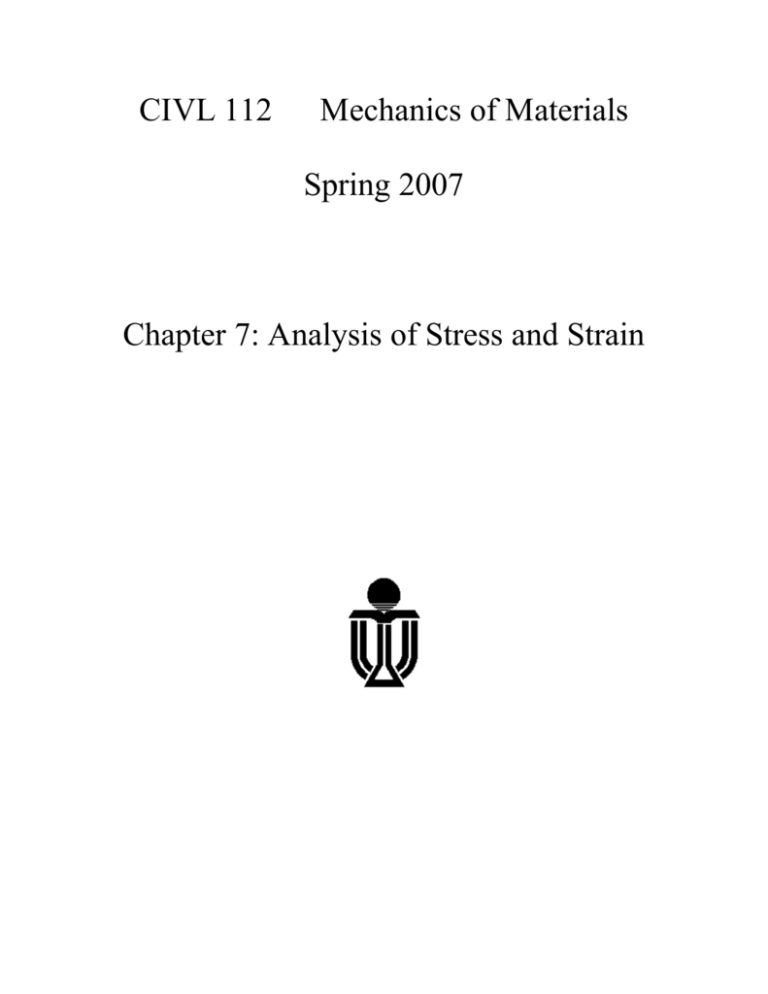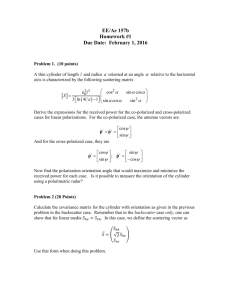plane maximum
advertisement

CIVL 112
Mechanics of Materials
Spring 2007
Chapter 7: Analysis of Stress and Strain
Typical problems:
What kind of
stresses ?
©2001 Brooks/Cole, a division of Thomson Learning, Inc. Thomson Learning ™ is a
trademark used herein under license.
Why?
Stresses on an inclined section
©2001 Brooks/Cole, a division of Thomson Learning, Inc. Thomson Learning™ is a trademark used herein under license.
DIY:
Write down the normal & tangential forces on
each plane (let A be the inclined area):
©2001 Brooks/Cole, a division of Thomson Learning, Inc. Thomson Learning™ is a trademark used herein under license.
(1) Left face:
(2) Bottom face:
(3) Inclined face:
Note that (1), (2) are expressed in the x-y
system while (3) is given in the x’-y’ system!
Transformation equations for plane stress
y
y'
sin
vector
v
unit
vector
along
cos
y
x'
cos
sin
unit vector along x
x
Fig. 1
Rotation matrix: R =
cos
sin
sin
cos
Recall from linear algebra:
R (v in old x-y frame) = v (in new x’-y’ frame)
Force equilibrium of wedge (in x’ and y’ directions)
x'
cos sin xy A sin x A cos
A
A sin A cos = 0
sin
cos
x ' y '
xy
y
Algebra (see Mathematica output)
x'
x y
2
x y
2
cos 2 xy sin 2 (7-4a)
and
x' y '
x y
2
sin 2 xy cos 2
y’x’ = x’y’
(7-4b)
(7.2)
(recall: shear stresses come in two equal & opposite pairs)
Still need y’ to completely describe state of stress in
primed frame
Note: in Fig. 1, if the rotation was + 90 rather than ,
then x’ becomes y’. Hence, to get y’, we can simply
substitute + 90 into in the x’ expression
y'
x y
2
x y
2
cos 2( 90) xy sin 2( 90)
With some trig. simplification
y'
x y
2
x y
2
cos 2 xy sin 2
(7-5)
Note (verified by Mathematica):
x + y = x’ + y’
(7-6)
(“trace of matrix does not change under transformation”)
abbreviations (7-4a,b) more succinct
A (x + y)/2; B (x – y)/2;
Hence (7-4a,b) become
x’ – A B cos 2 + xy sin 2
x’y’ = –B sin 2 + xy cos 2
(*)
To visualize them as f() more easily, let’s define constants
R, by requiring:
B R cos
xy R sin
(**)
Thus
R = (B2 +xy2)1/2
(T1)
Tan-1(xy /B )
(T2)
(Be careful with (T2) since Tan-1 results may be off by !!
ATAN2 is recommended if you use Excel)
Substituting (**) into (*)
x’ – A R cos cos 2 + R sin sin 2
x’y’ = –R cos sin 2 + R sin cos 2
or
x’ – A R cos(2 – )
x’y’ –R sin(2 – )
(T3)
(T4)
©2001 Brooks/Cole, a division of Thomson Learning, Inc. Thomson Learning™ is a trademark used herein under license.
Graph of x1 and x1y1 versus (for y = 0.2x and xy = 0.8x)
Example 7.2:
(determine stresses on tilted plane)
Homework on plane stress: 7.2-12, 18
Determination of largest ’ & ’ (as varies)
To find max (or min) x’:
Book: d/d (7.4a) = 0 …
Easier: in (T3), require Cos(…) = 1 for max / min, i.e.
2P – (for max x’), or
2P – (for min x’)
Hence
P1 =
P2 = +
These principal angles define the principal planes, which
are mutually perpendicular
The maximum and minimum normal stress act on the
respective principal planes, namely
max,min = A R
i.e.
max,min = (x + y)/2 {[(x – y)/2]2 +xy2}1/2 (7-17)
Since Cos(…) = 1, it makes Sin(…) = 0 in (T4), hence
there is no shear stress on the principal planes.
To find max (magnitude of) x’y’:
In (T4), require
sin(2 – ) = –1 for max x’y’ = R
(#)
2 –
maximum shear stress occurs on the plane where
S
Planes of maximum shear stress occur at 45 from the
principal planes. If we used +1 instead of –1 in (#), S
would result; that gives the plane with
maximum negative shear. Hence, in general,
S P
The magnitude of the maximum shear stress is
max = {(x – y)/2]2 +xy2}1/2
(7.25)
As RHS of (T3) vanishes when = S, the normal
stresses on planes of maximum shear are just the “average
stress”
x’ = A = (x + y)/2
(7.27)
Example 7.3
Find & sketch (a) Principal stresses; (b) Maximum shear
stresses.
Homework on maximum stress: 7.3-9, 17
Special cases of plane stress:
(1) Uniaxial stress: = 0; y = 0
Plugging these into (7.4ab) recover (2-29ab), i.e.
x'
x
2
and
x' y'
1 cos 2
x
2
sin 2
These explain why the most important orientations
(for uniaxial stress) are = 0 (max normal stress = x)
and = 45 (max shear = 0.5 x)
For axially loaded bars weak in shear, shear failure
often observed along 45 plane:
(2) Pure shear (x y = 0; xy= 0) (7-4ab) simplify
to:
x ' sin 2
(3-30a)
and
x ' y ' cos 2
(3-30b)
(3-30a) explains why brittle (weak in tension) material
under pure shear (e.g. torsion of a piece of chalk) often
fails along = 45 direction (a helical surface):
(3) Biaxial stress: xy = 0 (no shear stress) (e.g. in thinwalled pressure vessels (Ch. 8))
(T1,2) become R = B andTan-1(/B ) = 0,
hence, (T3,4) become
x’ = A B cos(2)
x’y’ –B sin(2)
Mohr’s circle for plane stress
22 x’ – A2x’y’2 = R2
This is a circle in - space,
- centered at (A, 0)
- radius = R
(7-32)
©2001 Brooks/Cole, a division of Thomson Learning, Inc. Thomson Learning™ is a trademark used herein under license.
Construction of Mohr’s circle:
In order to have (i) ’+ve = to the right; (ii)' : +ve = up,
and (iii) +ve = anti-clockwise on the Mohr circle plot,
need to change the sign convention for shear, and use
+ve sign on shears that tend to cause clockwise rotation
–ve sign in (T4) disappears, and circle goes anticlockwise at “constant speed” as increases.
With this new convention, and letting
u = x’ – A v = x’y’; t 2 – ,
we may visualize (T3,T4) as
u = R cos t
v = R sin t
v
t = 90° ( = /2 + 45°, i.e. max (-ve) shear stress)
t
R sin t
0 (transformed stress state)
R cos t
u
t =
2 t = 0 ( = /2, i.e. max x' )
= 0 (i.e. untransformed stress state)
Hence, we may use the following procedure:
1. From the given stresses, compute the center C = (A, 0)
and radius R, and plot the circle accordingly. Note that
the right/left quadrant point P1,2 give the maximum /
minimum normal stress, max, min = A R.
2. Using the stress state (x, xy) on face A (corresponding
to = 0), plot point A on the circle, and draw line AC.
3. To get the stress state for any given , simply rotate (anticlockwise) AC by 2 into AD, then coordinates of D give
(x’, x’y’). Note: if you find x’y’ < 0, remember to report
it as positive when you go back to “causing anticlockwise rotation = +ve shear” convention.
Example 7-5:
Given: x = 15000, y = 5000, xy = -4000 (in new
convention for plotting Mohr circles) (all in psi)
Find (a) stress state for = 40; (b) principal stresses; (c)
max. shear streses.
Usual calculations 10000, B = 5000,R =
6403.12423743
x'y'
2
x'
P
x'y'
2
min
'
The rest is all graphical; no need for trig. calculations
which are error-prone.
We can then use AutoCAD to obtain the Mohr circle (use
CIRCLE, LINE, ROTATE, ID, DIM, etc.)
Homework on Mohr’s circle: 7.4-12, 18 (use AutoCAD;
include the hardcopy with everything clearly labeled/
dimensioned) (report all answers to 0.01 MPa to show that
you did not use manual plotting)
Hooke’s Law for plane stress (z = 0)
x= z / E + (– y)/ E
x = (z – y)/ E
(7-34a)
Similarly
y= (y – x)/ E
Z = –(/E)(X + Y)
XY: distorts area (z face) rhombus,
XY = XY/G
(7.34b)
(7.34c)
(7.35)
Solving (7-34a,b) for the normal stresses,
The Mathematica output agrees with (7-36a,b). Also,
XY = GXY
(7.37)
(7-34) through (7-37): Hooke’s law for plane stress.
Note (see Ch.3) E, G and are not all independent,
but
G = E / [2 (1 + )]
(7-38)
Homework on Hooke’s law for plane stress: 7.5-1, 4
Mathematica Output:
Homework summary:
* Transformed stress: 7.2-12, 18
* Maximum stress: 7.3-9, 17
Mohr’s circle: 7.4-12, 18
Hooke’s law for plane stress: 7.5-1, 4
*: more important








